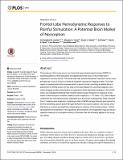| dc.contributor.author | Aasted, Christopher M. | en_US |
| dc.contributor.author | Yücel, Meryem A. | en_US |
| dc.contributor.author | Steele, Sarah C. | en_US |
| dc.contributor.author | Peng, Ke | en_US |
| dc.contributor.author | Boas, David A. | en_US |
| dc.contributor.author | Becerra, Lino | en_US |
| dc.contributor.author | Borsook, David | en_US |
| dc.date.accessioned | 2016-12-02T15:24:08Z | |
| dc.date.issued | 2016 | en_US |
| dc.identifier.citation | Aasted, Christopher M., Meryem A. Yücel, Sarah C. Steele, Ke Peng, David A. Boas, Lino Becerra, and David Borsook. 2016. “Frontal Lobe Hemodynamic Responses to Painful Stimulation: A Potential Brain Marker of Nociception.” PLoS ONE 11 (11): e0165226. doi:10.1371/journal.pone.0165226. http://dx.doi.org/10.1371/journal.pone.0165226. | en |
| dc.identifier.issn | 1932-6203 | en |
| dc.identifier.uri | http://nrs.harvard.edu/urn-3:HUL.InstRepos:29625974 | |
| dc.description.abstract | The purpose of this study was to use functional near-infrared spectroscopy (fNIRS) to examine patterns of both activation and deactivation that occur in the frontal lobe in response to noxious stimuli. The frontal lobe was selected because it has been shown to be activated by noxious stimuli in functional magnetic resonance imaging studies. The brain region is located behind the forehead which is devoid of hair, providing a relative ease of placement for fNIRS probes on this area of the head. Based on functional magnetic resonance imaging studies showing blood-oxygenation-level dependent changes in the frontal lobes, we evaluated functional near-infrared spectroscopy measures in response to two levels of electrical pain in awake, healthy human subjects (n = 10; male = 10). Each subject underwent two recording sessions separated by a 30-minute resting period. Data collected from 7 subjects were analyzed, containing a total of 38/36 low/high intensity pain stimuli for the first recording session and 27/31 pain stimuli for the second session. Our results show that there is a robust and significant deactivation in sections of the frontal cortices. Further development and definition of the specificity and sensitivity of the approach may provide an objective measure of nociceptive activity in the brain that can be easily applied in the surgical setting. | en |
| dc.language.iso | en_US | en |
| dc.publisher | Public Library of Science | en |
| dc.relation.isversionof | doi:10.1371/journal.pone.0165226 | en |
| dc.relation.hasversion | http://www.ncbi.nlm.nih.gov/pmc/articles/PMC5091745/pdf/ | en |
| dash.license | LAA | en_US |
| dc.subject | Biology and Life Sciences | en |
| dc.subject | Anatomy | en |
| dc.subject | Brain | en |
| dc.subject | Cerebral Cortex | en |
| dc.subject | Frontal Lobe | en |
| dc.subject | Medicine and Health Sciences | en |
| dc.subject | Hematology | en |
| dc.subject | Hemodynamics | en |
| dc.subject | Biochemistry | en |
| dc.subject | Proteins | en |
| dc.subject | Hemoglobin | en |
| dc.subject | Anesthesiology | en |
| dc.subject | Anesthesia | en |
| dc.subject | Pharmaceutics | en |
| dc.subject | Drug Therapy | en |
| dc.subject | Neuroscience | en |
| dc.subject | Brain Mapping | en |
| dc.subject | Functional Magnetic Resonance Imaging | en |
| dc.subject | Diagnostic Medicine | en |
| dc.subject | Diagnostic Radiology | en |
| dc.subject | Magnetic Resonance Imaging | en |
| dc.subject | Imaging Techniques | en |
| dc.subject | Radiology and Imaging | en |
| dc.subject | Neuroimaging | en |
| dc.subject | Spectrum Analysis Techniques | en |
| dc.subject | Infrared Spectroscopy | en |
| dc.subject | near-Infrared Spectroscopy | en |
| dc.subject | Prefrontal Cortex | en |
| dc.subject | Surgical and Invasive Medical Procedures | en |
| dc.subject | Functional Electrical Stimulation | en |
| dc.title | Frontal Lobe Hemodynamic Responses to Painful Stimulation: A Potential Brain Marker of Nociception | en |
| dc.type | Journal Article | en_US |
| dc.description.version | Version of Record | en |
| dc.relation.journal | PLoS ONE | en |
| dash.depositing.author | Aasted, Christopher M. | en_US |
| dc.date.available | 2016-12-02T15:24:08Z | |
| dc.identifier.doi | 10.1371/journal.pone.0165226 | * |
| dash.contributor.affiliated | Peng, Ke | |
| dash.contributor.affiliated | Aasted, Christopher M. | |
| dash.contributor.affiliated | Yücel, Meryem A. | |
| dash.contributor.affiliated | Becerra, Lino | |
| dash.contributor.affiliated | Borsook, David | |
| dash.contributor.affiliated | Boas, David | |


